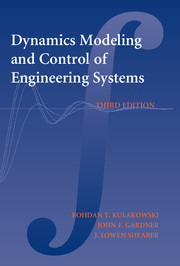Book contents
- Frontmatter
- Contents
- Preface
- Dynamic Modeling and Control of Engineering Systems
- 1 INTRODUCTION
- 2 MECHANICAL SYSTEMS
- 3 MATHEMATICAL MODELS
- 4 ANALYTICAL SOLUTIONS OF SYSTEM INPUT–OUTPUT EQUATIONS
- 5 NUMERICAL SOLUTIONS OF ORDINARY DIFFERENTIAL EQUATIONS
- 6 SIMULATION OF DYNAMIC SYSTEMS
- 7 ELECTRICAL SYSTEMS
- 8 THERMAL SYSTEMS
- 9 FLUID SYSTEMS
- 10 MIXED SYSTEMS
- 11 SYSTEM TRANSFER FUNCTIONS
- 12 FREQUENCY ANALYSIS
- 13 CLOSED-LOOP SYSTEMS AND SYSTEM STABILITY
- 14 CONTROL SYSTEMS
- 15 ANALYSIS OF DISCRETE-TIME SYSTEMS
- 16 DIGITAL CONTROL SYSTEMS
- APPENDIX 1 Fourier Series and the Fourier Transform
- APPENDIX 2 Laplace Transforms
- APPENDIX 3 MATLAB Tutorial
- APPENDIX 4 Simulink Tutorial
- Index
APPENDIX 3 - MATLAB Tutorial
Published online by Cambridge University Press: 05 June 2012
- Frontmatter
- Contents
- Preface
- Dynamic Modeling and Control of Engineering Systems
- 1 INTRODUCTION
- 2 MECHANICAL SYSTEMS
- 3 MATHEMATICAL MODELS
- 4 ANALYTICAL SOLUTIONS OF SYSTEM INPUT–OUTPUT EQUATIONS
- 5 NUMERICAL SOLUTIONS OF ORDINARY DIFFERENTIAL EQUATIONS
- 6 SIMULATION OF DYNAMIC SYSTEMS
- 7 ELECTRICAL SYSTEMS
- 8 THERMAL SYSTEMS
- 9 FLUID SYSTEMS
- 10 MIXED SYSTEMS
- 11 SYSTEM TRANSFER FUNCTIONS
- 12 FREQUENCY ANALYSIS
- 13 CLOSED-LOOP SYSTEMS AND SYSTEM STABILITY
- 14 CONTROL SYSTEMS
- 15 ANALYSIS OF DISCRETE-TIME SYSTEMS
- 16 DIGITAL CONTROL SYSTEMS
- APPENDIX 1 Fourier Series and the Fourier Transform
- APPENDIX 2 Laplace Transforms
- APPENDIX 3 MATLAB Tutorial
- APPENDIX 4 Simulink Tutorial
- Index
Summary
MATLAB OVERVIEW
MATLAB, an interactive and powerful engineering package from The MathWorks, Inc., is one of the most common software tools used in the analysis and design of dynamic systems and the control systems implemented on them. The basic package has many powerful numerical analysis functions as well as the ability to write scripts and functions to aid in repetitive analysis and to allow the user to augment the environment with custom capabilities.
Although it is likely that the reader will have a working knowledge of MATLAB, this tutorial is included to bring the uninitiated reader up to speed and to expose the casual user to several important features that are pertinent to this text. In this tutorial we cover the basic running environment of MATLAB (with its default windows), the fundamental data structure (the matrix), writing scripts and functions, and plotting data. We also explore some capabilities of the Control Systems Toolbox, which has many tools designed to aid in the analysis of dynamic systems. Appendix 4 contains a tutorial for Simulink, a MATLAB add-on, which allows for the rapid development of system simulations.
Launching MATLAB
Find MATLAB from the START menu on your computer and launch the application. Figure A3.1 shows the default frame with the three standard windows. The “current directory” window has an alternative window that you can access by clicking on the tab. Figure A3.2 shows the alternative window and describes its function.
- Type
- Chapter
- Information
- Dynamic Modeling and Control of Engineering Systems , pp. 438 - 462Publisher: Cambridge University PressPrint publication year: 2007



